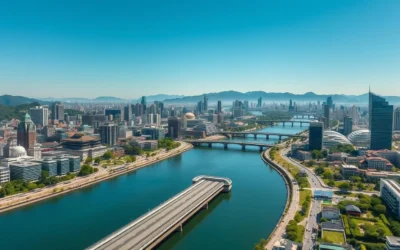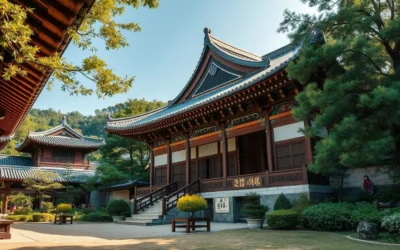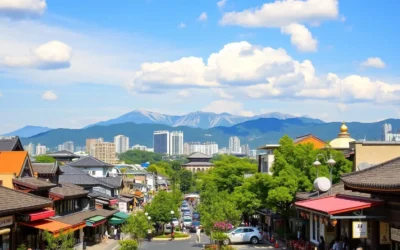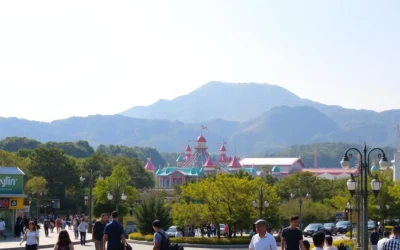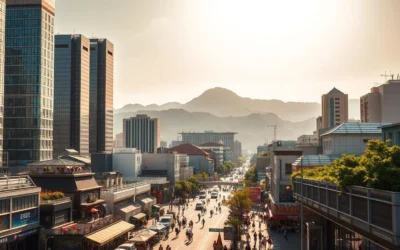✓ Accommodations✓ Flights✓ Rental Cars✓ Tours & Activities
Welcome to a breathtaking destination where nature’s wonders come alive. This guide will take you through the highlights of a place known for its volcanic origins and stunning landscapes. Rising as the highest peak in the region, this area is a must-visit for adventurers and nature lovers alike.
Formed by undersea volcanic eruptions, this location boasts a rich ecosystem. With over 1,800 plant species and 4,000 animal species, it’s a paradise for biodiversity enthusiasts. Whether you’re exploring its well-developed hiking trails or marveling at its mythic legends, there’s something for everyone.
Located on a picturesque island, this spot is not just a natural wonder but also a cultural treasure. From its UNESCO Biosphere Reserve status to its captivating stories, it’s a place where history and nature intertwine. Let’s dive into the best activities and top picks for your visit.
Overview of Hallasan National Park
Nestled on the stunning Jeju Island, this majestic peak offers a blend of natural beauty and cultural richness. As the highest point in the region, it stands tall at 1,947 meters above sea level. Its formation from undersea volcanic eruptions has created a diverse landscape that attracts adventurers and nature enthusiasts alike.
Located in the heart of Jeju Island, this area is a significant part of South Korea’s natural heritage. The park spans approximately 153 square kilometers, offering a variety of trails and scenic views. Whether you’re planning a day trip or a longer adventure, the park’s accessibility and breathtaking vistas make it a must-visit destination.
The park’s origins are rooted in volcanic activity, which has shaped its unique terrain. From lush forests to rugged peaks, the landscape is a testament to nature’s power. The mountain’s summit provides panoramic views that are worth the effort of the hike.
What makes a trip here truly memorable is the variety of activities available. Hiking is the most popular, with trails ranging from easy walks to challenging climbs. The park also holds cultural significance, being designated as a UNESCO Biosphere Reserve. This status highlights its importance in preserving biodiversity and cultural heritage.
Here’s a quick overview of the park’s hiking trails:
| Trail Name | Length (km) | Difficulty |
|---|---|---|
| Eorimok Trail | 6.8 | Moderate |
| Yeongsil Trail | 5.8 | Moderate |
| Seongpanak Trail | 9.6 | Challenging |
| Gwaneumsa Trail | 8.7 | Challenging |
| Eoseungsaengak Trail | 1.3 | Easy |
Whether you’re an experienced hiker or a casual visitor, the park offers something for everyone. Its trails, scenic beauty, and cultural depth ensure an unforgettable experience. Plan your trip to this iconic destination and immerse yourself in its wonders.
Hallasan National Park, South Korea: Best Things To Do – Top Picks
Discover a place where myth and nature intertwine to create unforgettable experiences. From legendary landmarks to breathtaking views, this destination offers a unique blend of activities that cater to every traveler. Whether you’re a nature enthusiast or a culture lover, there’s something here for you.
Highlighting Must-Do Activities
Start your journey by exploring the park’s iconic trails. The Seongpanak Course, stretching 9.6 kilometers, is a challenging yet rewarding option for hikers. Along the way, you’ll encounter stunning volcanic landscapes and lush forests. Don’t forget to stop by Baengnokdam Lake, a crater lake with a circumference of 3 kilometers.
Another must-do is spotting the legendary 500 stone sons. These unique rock formations are steeped in folklore and add a mystical touch to your visit. As one visitor shared,
“Seeing the stone sons felt like stepping into a storybook.”
For those seeking panoramic views, the summit offers a breathtaking vantage point. The hike to the top involves a total elevation gain of 1,230 meters, but the reward is worth the effort.
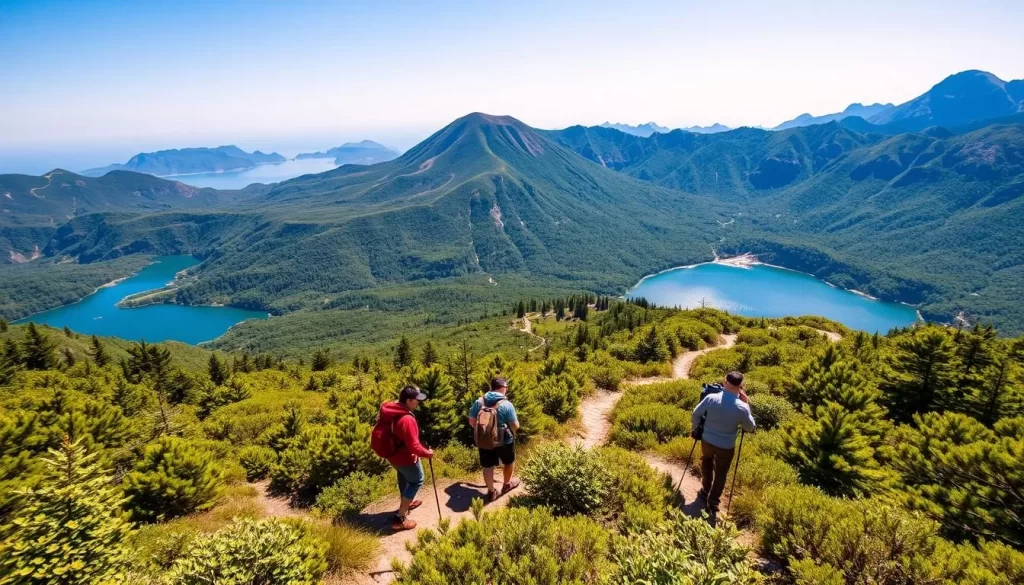
What Makes This Park Unique?
What sets this location apart is its seamless blend of myth and nature. The park’s designation as a UNESCO World Natural Heritage site highlights its global significance. Its volcanic origins have shaped a diverse ecosystem, making it a haven for biodiversity.
Visitors often describe their experience as transformative. One hiker noted,
“The combination of natural beauty and cultural depth made this trip unforgettable.”
This unique mix ensures that every activity enriches your overall experience.
| Activity | Highlights |
|---|---|
| Hiking | Explore trails like Seongpanak and Gwaneumsa, offering varying difficulty levels. |
| Spotting the 500 Stone Sons | Discover these legendary rock formations steeped in folklore. |
| Summit Views | Enjoy panoramic vistas from the highest peak in the region. |
Whether you’re hiking, exploring myths, or soaking in the views, this park offers a top-tier experience. Plan your visit and uncover the magic of this extraordinary destination.
Top Hiking Trails and Scenic Routes
Step into a world of natural wonders with some of the most scenic hiking trails in the region. Whether you’re a seasoned hiker or a beginner, these routes offer something for everyone. From challenging climbs to serene walks, each trail promises unforgettable views and unique experiences.
Exploring the Seongpanak and Gwaneumsa Trails
The Seongpanak Trail is a favorite among adventurers. Stretching 9.6 kilometers, it’s the longest route to the summit. The gradual incline makes it accessible, but the elevation gain of 1,230 meters ensures a rewarding challenge. Along the way, you’ll pass through lush forests and volcanic landscapes.
The Gwaneumsa Trail, at 8.7 kilometers, is another popular choice. Known for its rugged terrain, this path offers stunning views of basalt rock formations and alpine scenery. It’s a bit more demanding but equally rewarding.
Discovering the Yeongsil and Eorimok Trails
For a more relaxed experience, try the Yeongsil Trail. At 5.8 kilometers, it’s perfect for those who want to enjoy wildflowers and streams without a strenuous climb. The trail is dotted with designated rest areas, making it ideal for a leisurely hike.
The Eorimok Trail, at 6.8 kilometers, is another moderate option. It’s known for its beautiful displays of flora and fauna, especially during spring and fall. The path is well-marked, and the scenic lookout points are a highlight.
| Trail Name | Length (km) | Difficulty | Highlights |
|---|---|---|---|
| Seongpanak | 9.6 | Challenging | Summit views, lush forests |
| Gwaneumsa | 8.7 | Challenging | Basalt formations, alpine scenery |
| Yeongsil | 5.8 | Moderate | Wildflowers, streams |
| Eorimok | 6.8 | Moderate | Flora and fauna, lookout points |
Each trail offers a unique experience, so choose one that matches your fitness level and interests. Whether you’re seeking adventure or tranquility, these routes will leave you in awe of nature’s beauty.
Mythical Landmarks and Folklore
Step into a realm where ancient legends and natural wonders collide. The area’s volcanic origins have shaped not only its landscape but also its rich tapestry of myths. These stories, passed down through generations, add a layer of mystery to your visit.
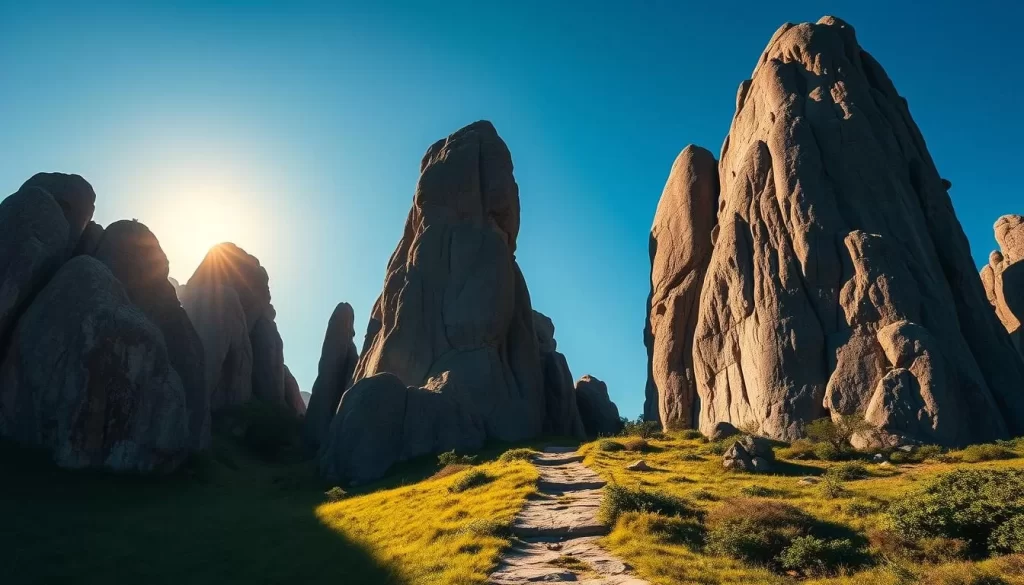
The Legend of the 500 Stone Sons
One of the most captivating tales is the legend of Grandmother Seolmundae and her 500 stone sons. According to folklore, she carried stones in her apron to build a bridge, but when the apron tore, the stones scattered across the land. These rock formations, now scattered throughout the area, are said to be her sons turned to stone.
The story is deeply rooted in the region’s cultural identity. It’s a reminder of the time when myths were used to explain natural phenomena. Visiting these formations feels like stepping into a storybook, especially during certain weather conditions when the atmosphere becomes even more mystical.
Unraveling Local Myths Along the Trails
As you explore the trails, you’ll encounter more stories tied to the land. The volcano’s presence is a recurring theme, with many myths explaining its creation and power. For instance, some tales speak of gods and spirits residing within the mountain, watching over the land.
Natural elements like rock formations and craters often play a central role in these stories. They serve as physical reminders of the myths, making your hike feel like a journey through both nature and history. The best time to experience this is early morning or late afternoon, when the light enhances the mystical ambiance.
| Myth | Significance |
|---|---|
| The 500 Stone Sons | Explains the scattered rock formations and highlights cultural heritage. |
| Volcanic Spirits | Connects the volcano’s power to local beliefs and traditions. |
| Grandmother Seolmundae | Symbolizes resilience and the region’s volcanic origins. |
These myths add depth to your visit, transforming a simple hike into a journey through time and legend. Whether you’re marveling at the rock formations or soaking in the views, the stories will stay with you long after you leave.
Photo Opportunities and Panoramic Views
Immerse yourself in a world where every corner offers a picture-perfect moment. From volcanic landscapes to alpine scenes, this destination is a photographer’s dream. Bring your camera and prepare to capture the interplay of water, forest, and plant life that creates dramatic daily landscapes.
Capturing Volcanic Landscapes and Alpine Scenes
One of the best spots for photography is the summit, offering sweeping views of the surrounding area. The volcanic terrain, combined with lush greenery, provides a striking contrast that’s perfect for your lens. Early morning or late afternoon is the ideal day time to capture the soft, golden light that enhances the scenery.
Another must-visit location is Baengnokdam Lake, a crater lake surrounded by unique rock formations. The reflection of the sky on the water creates a mesmerizing effect, especially during sunrise or sunset. Don’t forget to explore the trails lined with vibrant plant life, adding color and depth to your shots.
For those who love alpine photography, the Yeongsil Trail offers stunning views of wildflowers and streams. The interplay of light and shadow in the forest creates a magical atmosphere, perfect for capturing nature’s beauty.
Here are some specific lookout points to add to your itinerary:
- Seongsan Ilchulbong Peak: Known for its sunrise views and dramatic volcanic cliffs.
- Eorimok Trail: Offers panoramic views of the forest and surrounding peaks.
- Gwaneumsa Trail: Features rugged terrain and stunning alpine scenery.
Plan your visit during the optimal times of the day to make the most of the natural light. Whether you’re a professional photographer or a casual traveler, these spots will leave you with unforgettable memories and stunning photos.
Seasonal Highlights and Natural Beauty
Experience the ever-changing beauty of nature as each season transforms the landscape into a unique masterpiece. From vibrant wildflowers in spring to fiery autumn leaves and snowy winter wonderlands, this destination offers something special year-round. Plan your visit to witness the dramatic shifts in scenery and immerse yourself in the magic of the seasons.
Spring Wildflower Blooms and Autumn Color Spectacles
In spring, the park comes alive with a burst of color as wildflowers blanket the landscape. Cherry blossoms bloom from late March to early April, creating a picturesque setting for hikes and photography. The trails are lined with vibrant blooms, offering a feast for the eyes and a perfect backdrop for your adventures.
Autumn brings its own charm, with tree leaves turning shades of red, orange, and gold. The crisp air and clear skies enhance the beauty of the landscape, making it an ideal time for hiking. The contrast between the fiery foliage and the blue sky is truly breathtaking.
Winter Snow Adventures and Snowshoeing Tips
When winter arrives, the park transforms into a snowy paradise. The landscape is blanketed in white, offering a serene and peaceful atmosphere. Snowshoeing is a popular activity, allowing you to explore the trails in a new way. The crisp, clear mountain views are worth braving the cold.
To make the most of your winter visit, dress in layers and wear waterproof boots. Timing is key—early mornings often provide the best light for photography and the quietest trails. Don’t forget to bring a thermos of hot tea to keep warm as you enjoy the snowy scenery.
- Spring: Witness wildflower blooms and cherry blossoms from late March to early April.
- Autumn: Enjoy fiery foliage and mild weather, perfect for hiking.
- Winter: Explore snowy trails and crisp mountain views with snowshoeing adventures.
Each season offers a unique way to experience the park’s natural beauty. Whether you’re drawn to the vibrant colors of spring, the warm hues of autumn, or the snowy charm of winter, there’s always something to inspire your next visit.
Planning Your Trip and Practical Tips
Make the most of your adventure with these essential tips for planning your trip. Whether you’re arriving by car or public transport, knowing the best way to get around will save you time and stress. Here’s everything you need to know to ensure a smooth and enjoyable visit.
Transportation and Parking Information
If you’re flying into Jeju, renting a car is one of the most convenient ways to explore the area. The drive to the park takes about an hour, depending on your starting point. Public buses are also available, but they may take longer and require transfers.
Parking near the trailheads can fill up quickly, especially during peak seasons. Arrive early to secure a spot and avoid delays. Some trails have designated parking areas, so check the specific route you plan to take.
Safety and Weather Preparedness
The weather in the mountains can change rapidly, so always check the forecast before heading out. Dress in layers and bring waterproof gear to stay comfortable in variable conditions. Starting your hike early in the morning not only helps you avoid crowds but also ensures you have enough daylight to complete your journey.
Here are some additional tips to keep in mind:
- Carry enough water and snacks for the hike, as there are limited facilities along the trails.
- Wear sturdy hiking shoes to navigate the rugged terrain safely.
- Inform someone about your plans and expected return time, especially if you’re hiking alone.
For more detailed travel advice, check out this South Korea travel guide to enhance your trip planning.
Family-Friendly Activities and Relaxation Spots
Looking for a perfect family getaway? This destination offers a mix of adventure and relaxation for all ages. With gentle trails and scenic picnic areas, it’s an ideal spot for a day out with your loved ones.

Easy Trails and Picnic Areas
For families with young children or those looking for a leisurely stroll, the Eoseungsaengak Trail is a great choice. At just 1.3 kilometers, it’s short and easy, making it perfect for a relaxed visit. The trail is well-marked and offers beautiful views of the surrounding landscape.
Another excellent option is the Yeongsil Trail, known for its wildflowers and streams. This 5.8-kilometer path is moderate in difficulty but provides plenty of rest spots along the way. It’s a fantastic spot to take a break and enjoy a picnic amidst nature.
Here are some highlights for a family-friendly outing:
- Gentle Trails: Explore paths like Eoseungsaengak and Yeongsil, perfect for all ages.
- Picnic Areas: Designated spots along the trails allow you to relax and enjoy a meal in nature.
- Scenic Beauty: Enjoy breathtaking views without the need for strenuous hikes.
For more ideas on family-friendly activities, check out this guide to Jeju Island. It’s packed with tips to make your visit unforgettable.
Whether you’re planning a short outing or a full-day adventure, this destination offers something for everyone. From easy trails to cozy picnic spots, it’s the perfect spot to create lasting memories with your family.
Exploring Local Cuisine and Dining Options
Exploring the local cuisine is an essential part of any trip to this stunning area. From trailhead cafes to traditional Korean snacks, the food here adds a flavorful layer to your adventure. Whether you’re refueling after a hike or simply enjoying a meal with a view, the dining options are as memorable as the scenery.
Trailhead Cafes and Traditional Korean Snacks
After a long hike, there’s nothing better than stopping by a trailhead cafe. These cozy spots offer a lot of options, from hearty soups to refreshing beverages. Many cafes serve traditional Korean dishes like bibimbap and kimchi stew, giving you a taste of the local culture.
For a quick snack, try some tteokbokki (spicy rice cakes) or odeng (fish cake skewers). These treats are not only delicious but also provide the energy you need to keep exploring. The combination of flavors and textures makes them a favorite among hikers.
Here’s why local cuisine enhances your experience:
- Convenience: Trailhead cafes are strategically located, making it easy to refuel before or after your hike.
- Cultural Insight: Traditional dishes offer a glimpse into the region’s culinary heritage.
- Energy Boost: Snacks like tteokbokki are perfect for keeping your energy levels high.
For more insights into the culinary delights of Jeju Island, check out this guide. It’s packed with tips to make your dining experience unforgettable.
Whether you’re at the peak of your hike or just starting out, the local cuisine adds a unique touch to your journey. Don’t miss the chance to savor the flavors of this beautiful area.
Essential Gear and Hiking Preparation
Preparing for your hike starts with the right gear and mindset. Whether you’re tackling a challenging trail or enjoying a leisurely walk, having the proper equipment ensures a safe and enjoyable experience. From clothing layers to emergency supplies, here’s what you need to know before hitting the trails.
What to Pack for Every Season
Your packing list should adapt to the season. In colder months, layering is key. Start with a moisture-wicking base layer, add an insulating mid-layer, and finish with a waterproof outer shell. For warmer weather, lightweight and breathable fabrics are essential.
Footwear is another critical consideration. Sturdy hiking boots with good ankle support are a must, especially for uneven terrain. Don’t forget to break them in before your hike to avoid blisters.
Here’s a quick checklist for your essentials:
- Clothing: Layered outfits, waterproof jacket, hat, and gloves.
- Footwear: Hiking boots or trail shoes with good grip.
- Food: High-energy snacks like nuts, granola bars, and dried fruit.
- Water: At least one liter per person, more for longer hikes.
- Emergency Supplies: First aid kit, map, compass, and flashlight.
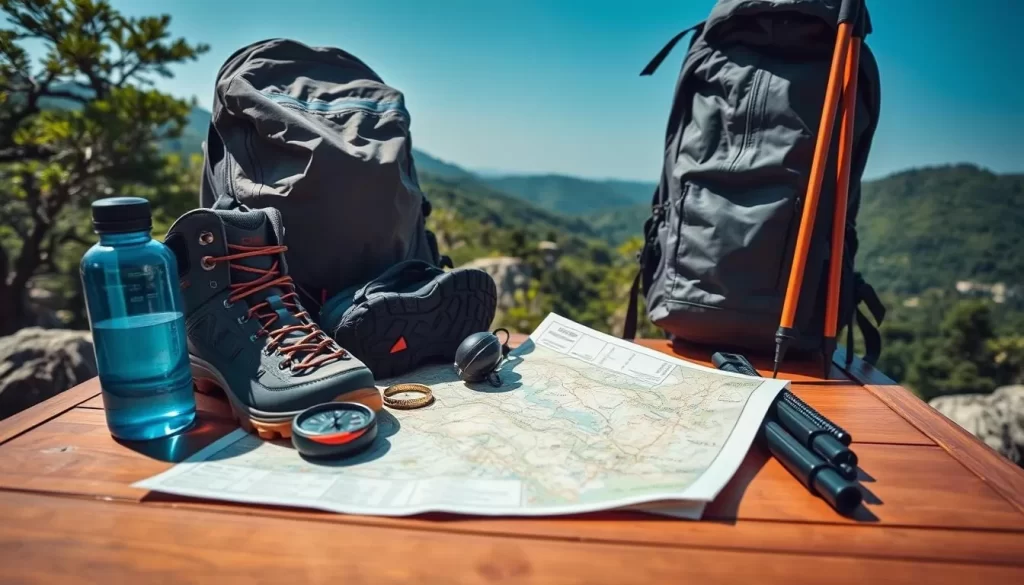
Tips for a Comfortable Hike
Comfort on the trail begins with preparation. Start by checking the weather forecast and trail conditions. This helps you plan your clothing and gear accordingly.
Hydration and nutrition are vital. Carry enough water and pack snacks that provide sustained energy. Foods like trail mix and energy bars are lightweight and easy to eat on the go.
For more detailed advice on winter hiking, check out this guide to winter hiking essentials. It’s packed with tips to keep you safe and comfortable in colder conditions.
| Season | Essential Gear |
|---|---|
| Winter | Insulated layers, waterproof boots, crampons, trekking poles |
| Summer | Lightweight clothing, sun hat, sunscreen, extra water |
| Spring/Fall | Layered clothing, rain jacket, sturdy footwear |
Tailor your packing list to the season and trail difficulty. With the right preparation, you’ll be ready to tackle any adventure with confidence.
Additional Adventures on Jeju Island
Jeju Island offers more than just its famous peak—it’s a treasure trove of diverse experiences waiting to be explored. Beyond the trails and volcanic landscapes, you’ll find caves, gardens, and beaches that add depth to your visit. Whether you’re a couple seeking romance or a dedicated hiker craving new challenges, these attractions enrich your island adventure.
Nearby Attractions Beyond the National Park
Start with Manjanggul Cave, a UNESCO World Natural Heritage site. This 7.4-kilometer lava tube showcases unique rock formations and a cool, otherworldly atmosphere. It’s a must-visit for anyone fascinated by geology or history.
For a burst of color, head to Camellia Hill Botanical Garden. Home to approximately 6,000 camellia trees, this garden is a paradise for nature lovers and photographers. Stroll through the vibrant pathways and enjoy the serene ambiance.
If you’re a couple looking for a romantic spot, Seongsan Ilchulbong Peak is perfect. Known as a UNESCO World Heritage site, it offers breathtaking sunrise views and clear visibility for scuba diving. The peak’s rich biodiversity adds to its charm.
For hikers seeking more trails, the Yongmeori Coast offers a scenic 2-hour walk. The coastal views and unique rock formations make it a memorable experience. It’s a great way to explore Jeju’s coastal beauty.
| Attraction | Highlights |
|---|---|
| Manjanggul Cave | 7.4-kilometer lava tube, UNESCO site |
| Camellia Hill Botanical Garden | 6,000 camellia trees, vibrant pathways |
| Seongsan Ilchulbong Peak | Sunrise views, scuba diving |
| Yongmeori Coast | 2-hour coastal walk, unique rock formations |
Planning an itinerary that includes these attractions ensures a well-rounded trip. For more ideas, check out this Jeju Island adventure guide or this Jeju itinerary. These resources will help you make the most of your visit.
Whether you’re exploring caves, wandering through gardens, or hiking coastal trails, Jeju Island offers endless opportunities for discovery. Don’t limit yourself to one destination—embrace the island’s full potential and create unforgettable memories.
Conclusion
From volcanic peaks to lush trails, this destination offers a perfect blend of adventure and tranquility. With over 2,000 plant species and 4,000 animal species, it’s a haven for biodiversity enthusiasts. Whether you’re hiking scenic routes or exploring mythical landmarks, every moment here is unforgettable.
The unique mix of natural beauty and cultural depth makes this place truly special. From the legendary 500 stone sons to the panoramic summit views, there’s something for every visitor. Seasonal highlights, like spring wildflowers and autumn foliage, add to its charm.
Practical tips ensure a smooth experience. Dress in layers, carry essentials, and start early to make the most of your day. Don’t forget to savor local cuisine at trailhead cafes, where traditional dishes like bibimbap await.
Ready to explore? Plan your trip to this remarkable place and create your own adventure. For more travel inspiration, check out this South Korea travel guide.
The above is subject to change.
Check back often to TRAVEL.COM for the latest travel tips and deals.

